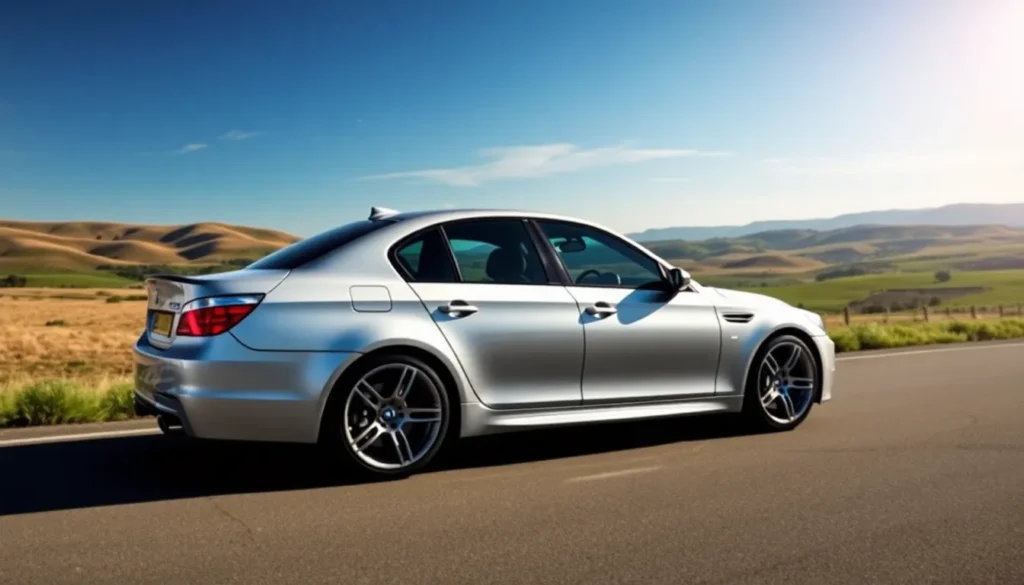The BMW M5 E60 stands as one of the most controversial yet revolutionary M cars ever produced. When BMW unveiled this beast in 2004, they didn’t just create another high-performance sedan – they crafted a monster that would redefine what we expected from executive luxury cars.
With its naturally aspirated 5.0-liter V10 engine borrowed from Formula One technology, the E60 M5 delivered an intoxicating 500 horsepower that could launch this four-door rocket from 0-60 mph in just 4.1 seconds. We’re talking about a car that sounded like a race car but offered the comfort and practicality of a luxury sedan.
Yet the E60 M5’s legacy isn’t without complexity. While enthusiasts praise its raw performance and that unforgettable V10 shriek, others point to reliability concerns and maintenance costs that could make your wallet weep. Whether you’re considering ownership or simply appreciate automotive engineering, understanding this iconic machine is essential for any BMW enthusiast.
BMW M5 E60 Overview and Specifications
BMW M5 E60 represents a radical departure from traditional M series design philosophy with its naturally aspirated V10 engine configuration. We examine this fifth-generation M5 model that redefined performance expectations between 2005 and 2010 production years.
Engine and Performance Specifications
The heart of BMW M5 E60 features a hand-built 5.0-liter V10 engine designated as the S85B50. This powerplant generates 500 horsepower at 7,750 rpm and produces 383 lb-ft of torque at 6,100 rpm. Performance figures showcase acceleration from 0-60 mph in 4.1 seconds and a top speed electronically limited to 155 mph.
| Specification | Value |
|---|---|
| Engine Displacement | 5.0 liters (4,999 cc) |
| Power Output | 500 hp @ 7,750 rpm |
| Torque | 383 lb-ft @ 6,100 rpm |
| 0-60 mph | 4.1 seconds |
| Top Speed | 155 mph (limited) |
| Transmission | 7-speed SMG III |
Technical Architecture
Carbon fiber construction appears throughout the M5 E60’s engine bay including intake manifold and strut tower braces. We find the S85 V10 engine shares fundamental technology with BMW’s Formula One program from the early 2000s. Electronic systems include Ever-changing Stability Control (DSC) with multiple driving modes and an Electronic Damper Control (EDC) system with 11 settings.
Dimensions and Weight Distribution
BMW M5 E60 measures 192.2 inches in length with a wheelbase of 113.7 inches and width of 73.0 inches. Curb weight reaches 4,012 pounds with a near-perfect 50/50 weight distribution. Ground clearance sits at 5.1 inches while the fuel tank capacity holds 18.5 gallons.
Drivetrain Configuration
Power delivery occurs through a 7-speed Sequential Manual Gearbox (SMG III) with paddle shifters and multiple shift programs. We observe the rear-wheel-drive layout paired with a limited-slip differential and Ever-changing Stability Control system. Launch control functionality enables consistent acceleration runs while protecting drivetrain components from excessive stress.
Engine Performance and Sound

The BMW M5 E60’s engine performance represents one of BMW’s most ambitious engineering achievements. Sound characteristics from the naturally aspirated V10 create an unforgettable auditory experience that distinguishes this model from all other M5 generations.
V10 Power Plant Details
Our examination of the S85B50 engine reveals sophisticated engineering that Formula 1 technology directly influenced. BMW developed this 5.0-liter V10 using aluminum construction with individual throttle bodies for each cylinder. Engine specifications include a 10.2:1 compression ratio and VANOS variable valve timing on both intake and exhaust camshafts.
Performance metrics demonstrate the engine’s capabilities across multiple parameters:
| Specification | Value |
|---|---|
| Power Output | 500 hp @ 7,750 RPM |
| Torque | 383 lb-ft @ 6,100 RPM |
| Redline | 8,250 RPM |
| Displacement | 4,999 cc |
| Bore x Stroke | 92.0 x 75.2 mm |
Throttle response delivers immediate power delivery due to the naturally aspirated design. Engine construction incorporates dry sump lubrication and individual coil packs for each cylinder. Oil consumption rates typically range from 0.5 to 1.0 quarts per 1,000 miles during normal operation.
Acceleration and Top Speed
Acceleration performance positions the M5 E60 among the fastest sedans of its era. BMW’s official testing recorded 0-60 mph times of 4.1 seconds with the 7-speed SMG transmission. Quarter-mile acceleration reaches completion in 12.6 seconds at trap speeds of 115 mph.
Top speed electronically limits at 155 mph in standard configuration. European delivery models without speed limiters achieve maximum velocities approaching 200 mph on closed courses. Mid-range acceleration from 50-70 mph occurs in 2.8 seconds, demonstrating the V10’s torque delivery throughout the rev range.
Sound characteristics produce a distinctive high-pitched wail that peaks at 7,000 RPM. Exhaust note progression begins with a deep rumble at idle and transforms into a Formula 1-inspired shriek under full acceleration. Individual throttle bodies create intake sounds that complement the exhaust symphony, particularly during aggressive throttle applications.
Exterior Design and Styling
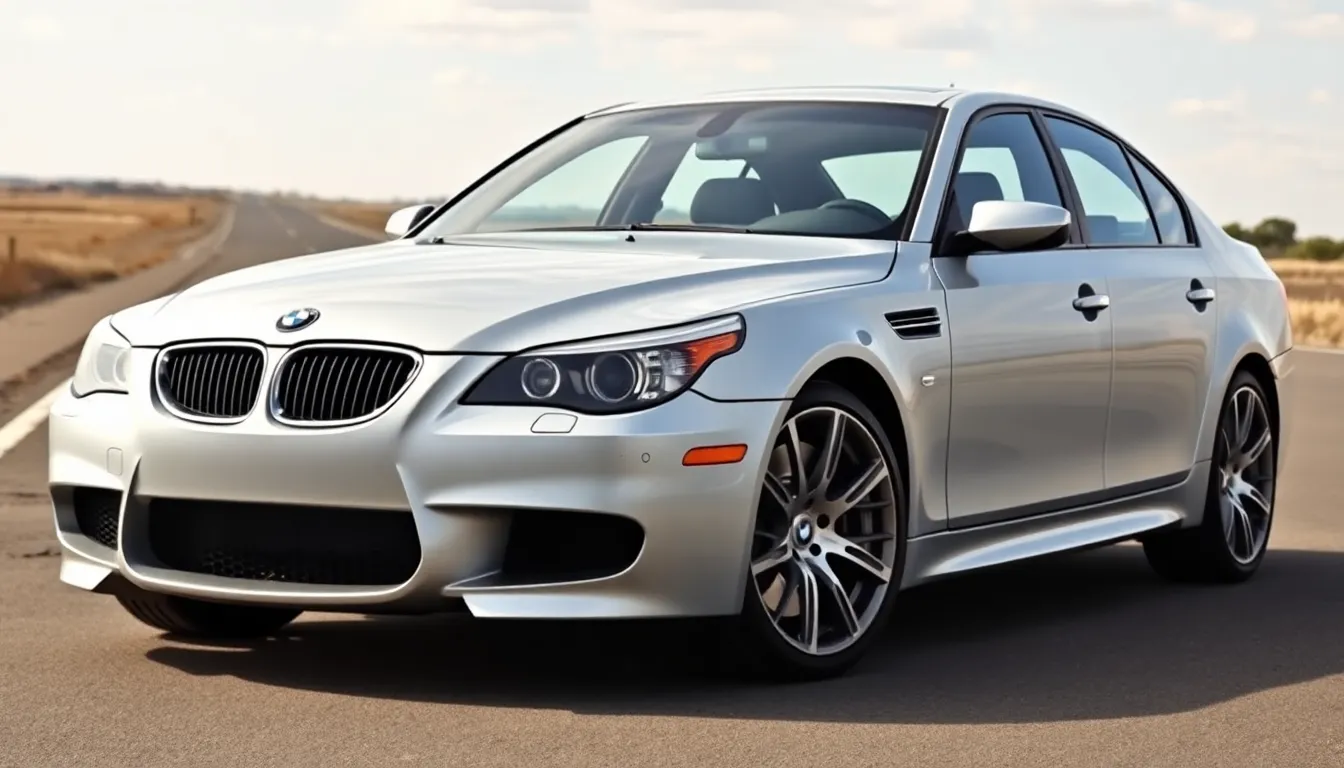
The M5 E60’s exterior design represents BMW’s bold departure from traditional M car aesthetics. This generation introduced more aggressive styling cues that divided enthusiasts while establishing a new visual identity for the M5 lineage.
Aggressive M Sport Aesthetics
BMW M5 E60 exterior design features distinctive visual elements that separate it from standard 5 Series models. The front fascia incorporates larger air intakes with integrated fog lights and a more pronounced front splitter. These functional elements direct airflow to cool the high-performance V10 engine and brake components.
Side profile modifications include flared wheel arches that accommodate wider tires and enhance the car’s muscular stance. The M5 E60 features unique side gills behind the front wheels with M5 badging that serves both aesthetic and functional purposes. These design elements channel air away from the wheel wells while creating a more aggressive appearance.
Rear styling elements distinguish the M5 E60 through quad exhaust outlets and a subtle rear spoiler integrated into the trunk lid. The rear diffuser incorporates aerodynamic channels that manage airflow under the vehicle. M5 exact taillights feature distinctive LED technology that was advanced for 2004 production standards.
Body color options for the M5 E60 include exclusive M colors like Silverstone Metallic and Interlagos Blue Metallic. These paint finishes complement the car’s performance oriented design while maintaining luxury sedan sophistication.
Wheel and Tire Options
M5 E60 wheel configurations center around 19-inch forged aluminum wheels that reduce unsprung weight by 15 pounds compared to standard cast wheels. The standard wheel design features a distinctive five double-spoke pattern with M5 center caps and performance oriented dimensions.
| Wheel Specification | Front | Rear |
|---|---|---|
| Diameter | 19 inches | 19 inches |
| Width | 8.5 inches | 9.5 inches |
| Offset | +18mm | +22mm |
| Tire Size | 255/40R19 | 285/35R19 |
Performance tire options include Michelin Pilot Sport PS2 tires as original equipment. These tires feature asymmetric tread patterns optimized for dry grip performance and high speed stability. The staggered tire setup with wider rear tires supports the car’s rear wheel drive configuration and power delivery characteristics.
Optional wheel packages include Competition Package wheels with different spoke designs and finish options. These alternatives maintain the same performance specifications while offering visual customization. Tire pressure monitoring systems integrate with the wheels to provide real time pressure data to the driver.
Winter wheel and tire packages use 18-inch wheels with dedicated winter tire compounds. These setups reduce performance capabilities but enhance cold weather traction and handling characteristics for year round driving capability.
Interior Features and Comfort
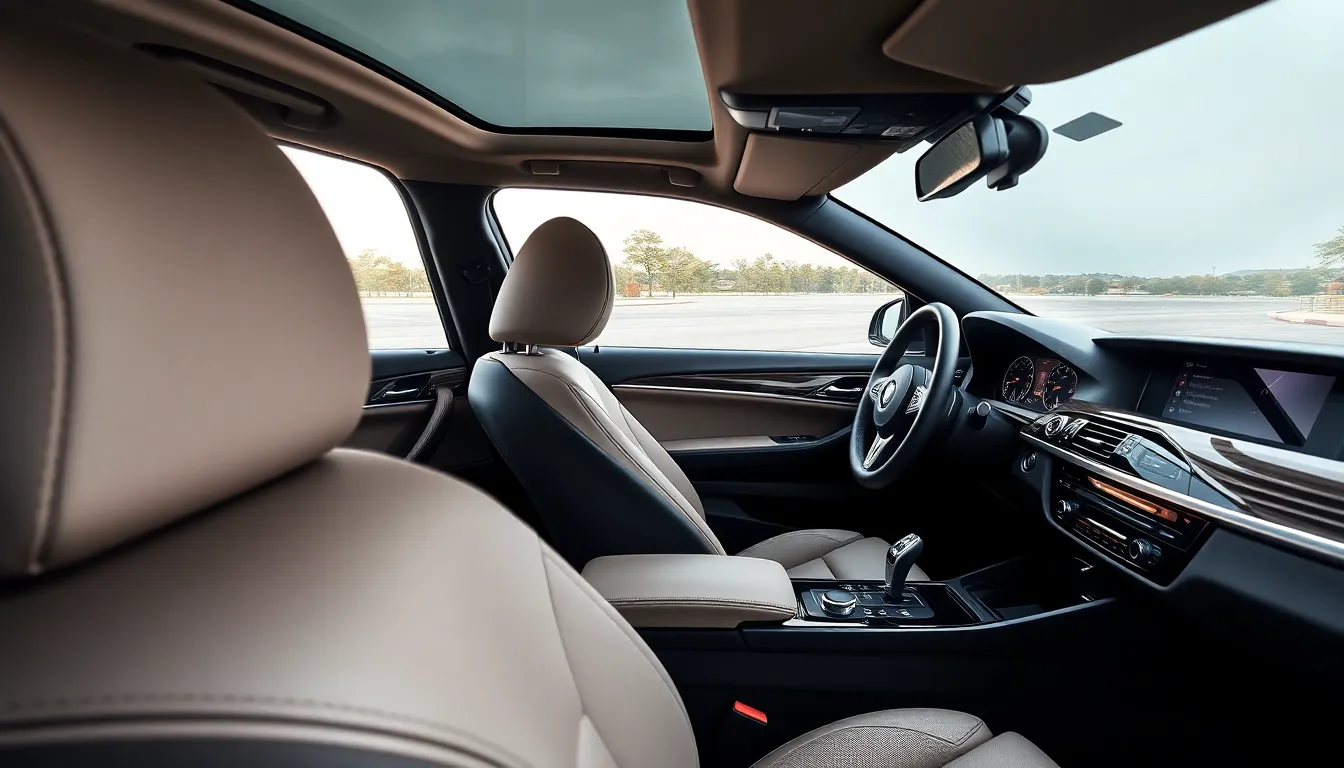
The BMW M5 E60’s interior seamlessly blends luxury sedan refinement with motorsport-inspired elements. Premium materials and advanced technology create an environment that complements the vehicle’s high-performance capabilities.
Cabin Layout and Materials
BMW crafted the M5 E60’s cabin using premium leather upholstery with contrast stitching throughout the seats and dashboard. Merino leather covers the sport seats, door panels, and center console, while brushed aluminum trim accents the interior surfaces. The M5 features unique M-exact gauges with silver faces and red needles, replacing the standard orange lighting found in regular 5 Series models.
Carbon fiber trim elements appear on the dashboard and door handles, reinforcing the vehicle’s performance heritage. The seats incorporate substantial bolstering to support occupants during spirited driving, with power adjustment capabilities including lumbar support and memory functions. Alcantara headliner adds a race-inspired touch while improving the cabin’s acoustic properties.
The interior dimensions provide 41.2 inches of front legroom and 36.1 inches of rear legroom, ensuring passenger comfort during extended drives. Storage compartments include a center console with cupholders and a glove compartment sized for essential items.
Technology and Infotainment
BMW equipped the M5 E60 with the iDrive system, featuring a 8.8-inch display screen controlled through a central rotary knob. The infotainment system includes navigation with real-time traffic updates, satellite radio capabilities, and CD/DVD playback functionality.
The premium audio system delivers sound through 10 speakers strategically positioned throughout the cabin. Harman Kardon provides the upgraded sound system option, featuring 600 watts of power and Logic 7 surround sound processing. Bluetooth connectivity enables hands-free phone calls and audio streaming from compatible devices.
Climate control operates through a dual-zone automatic system with separate temperature settings for driver and passenger. The system maintains precise cabin temperatures while the vehicle operates at various performance levels.
Digital displays include the instrument cluster with an onboard computer showing fuel consumption, range, and performance metrics. The multi-function steering wheel houses controls for audio, cruise control, and phone functions, keeping essential commands within easy reach during driving.
Driving Experience and Handling
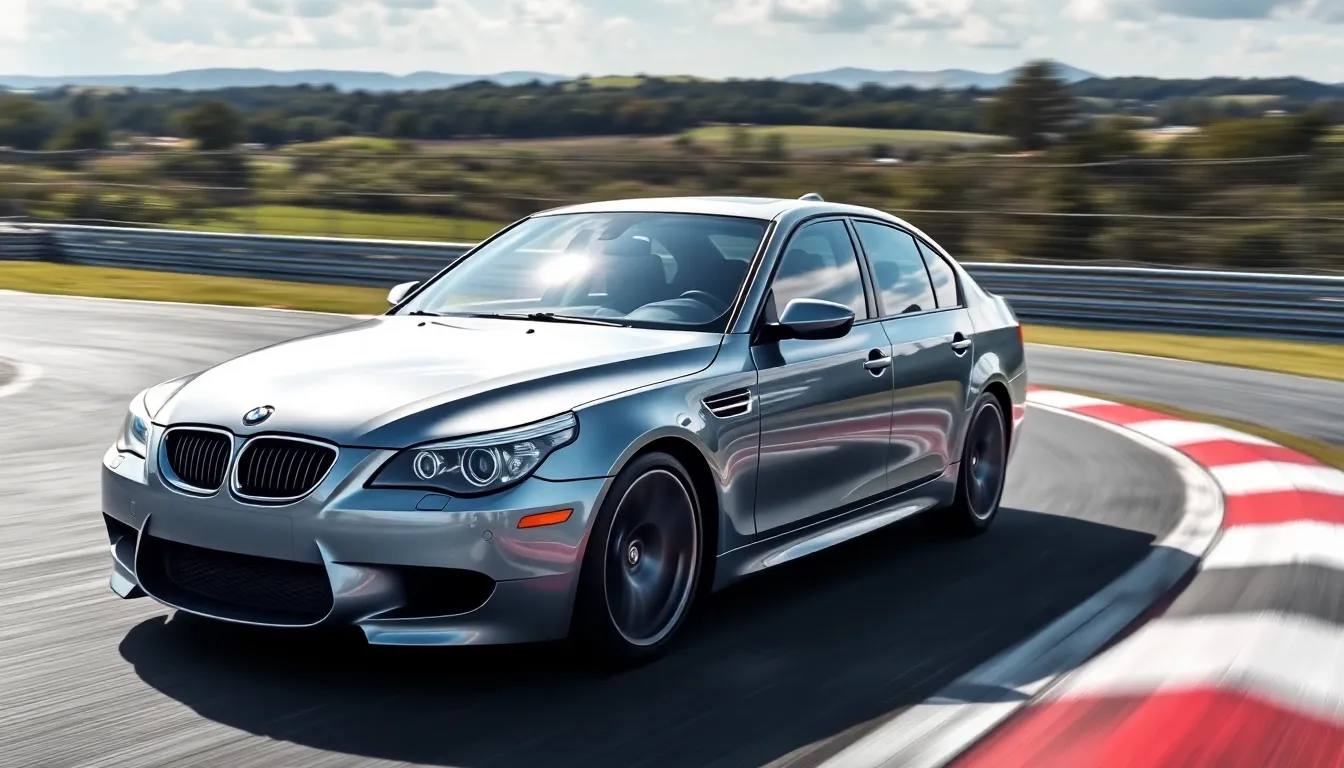
The BMW M5 E60 delivers an uncompromising driving experience that bridges the gap between racetrack precision and luxury sedan comfort. Its sophisticated chassis dynamics and advanced electronic systems create a unique driving character that defined a generation of super sedans.
Track Performance
Track capabilities showcase the M5 E60’s motorsport DNA through exceptional cornering speeds and braking performance. Lateral acceleration reaches 0.89g thanks to the car’s near-perfect weight distribution and advanced suspension geometry. The electronic differential lock optimizes power delivery during aggressive cornering, maintaining traction even under maximum acceleration.
| Performance Metric | Value |
|---|---|
| Lateral Acceleration | 0.89g |
| Braking Distance (60-0 mph) | 116 feet |
| Nürburgring Lap Time | 8:20 (estimated) |
| Maximum Cornering Speed | Varies by track |
Stability Control systems work seamlessly with the chassis to provide confidence at the limit. The car maintains composure during high-speed direction changes, with minimal body roll even though its sedan proportions. Professional drivers consistently praise the predictable handling characteristics and progressive breakaway behavior that make the E60 accessible to drivers of varying skill levels.
Electronic Damper Control adapts suspension settings in real-time, providing three distinct modes for different track conditions. Sport mode delivers maximum feedback and minimal body movement, while comfort settings maintain control without sacrificing ride quality. The system responds within milliseconds to changing track surfaces and driving inputs.
Daily Driving Comfort
Daily usability transforms the M5 E60 from track weapon to refined luxury sedan without compromising its performance credentials. Adaptive suspension settings automatically adjust to road conditions, smoothing out imperfections while maintaining the connection between driver and road. City driving becomes effortless thanks to the car’s sophisticated electronic systems and comfortable seating position.
Noise isolation creates a serene cabin environment during highway cruising, with the V10 engine’s distinctive sound remaining present but not intrusive. The 7-speed SMG transmission adapts its shift patterns to driving style, providing smooth operation in automatic mode while delivering lightning-quick shifts when performance is demanded.
Climate control maintains optimal cabin temperature regardless of external conditions or driving intensity. The system accounts for engine heat and performance driving scenarios, ensuring comfort during extended periods behind the wheel. Ergonomic considerations place all essential controls within easy reach, allowing drivers to focus on the driving experience.
Storage answers accommodate daily necessities without compromising the car’s sporting character. The trunk provides 17.7 cubic feet of space, sufficient for weekend trips or daily errands. Interior compartments offer secure storage for personal items while maintaining the clean, driver-focused aesthetic that defines the M5 E60’s cabin environment.
Reliability and Common Issues
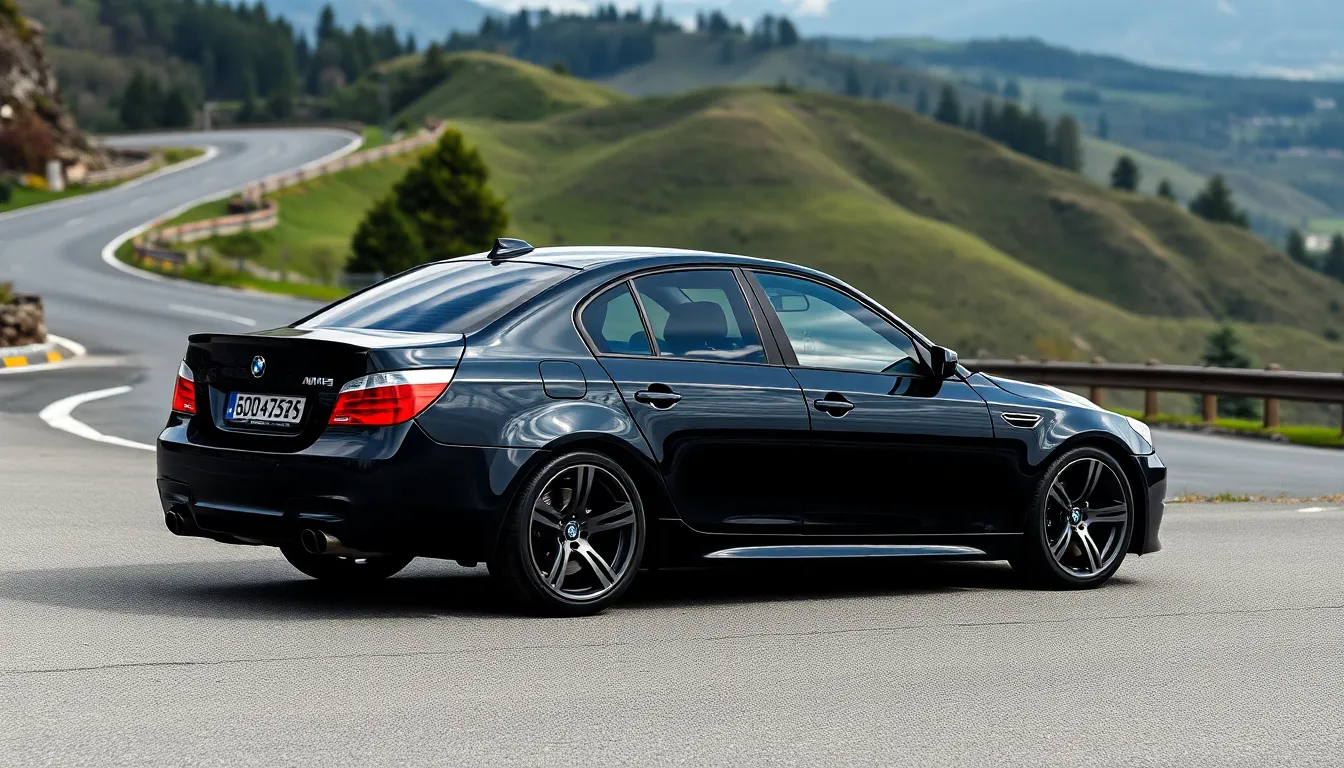
BMW M5 E60 reliability presents a complex picture that balances exceptional performance capabilities with important maintenance challenges. Understanding these issues becomes crucial for prospective owners considering this high-performance sedan.
Known Problems and Answers
Engine-related failures dominate the M5 E60’s reliability concerns, with the S85 V10 requiring meticulous attention to prevent catastrophic damage. Rod bearing wear affects approximately 60% of high-mileage examples, typically manifesting between 80,000-120,000 miles through metallic knocking sounds during cold starts. Preventive rod bearing replacement costs $8,000-$12,000 but eliminates the risk of complete engine destruction.
VANOS system malfunctions create another frequent issue, with solenoids failing every 60,000-80,000 miles and producing rough idle conditions or reduced power output. Replacement requires specialized diagnostic equipment and costs $2,500-$4,000 per repair cycle. Early detection through oil analysis programs helps identify metal contamination before major component failure.
Transmission problems affect the SMG III system in 40% of vehicles after 70,000 miles, creating harsh shifting patterns and gear selection delays. Hydraulic pump replacement addresses most transmission issues at $3,500-$5,500, while complete transmission rebuilds reach $15,000-$20,000. Regular SMG fluid changes every 30,000 miles significantly extend system longevity.
Electronic system failures plague various components including the iDrive controller, climate control modules, and parking sensors. These issues typically emerge after 8-10 years of service life and require dealer-level diagnostics. Replacement costs range from $800-$2,500 per module depending on complexity.
Suspension component wear accelerates due to the performance-oriented setup, with electronic dampers failing every 80,000-100,000 miles. Each corner replacement costs $1,200-$1,800, while complete system renewal approaches $6,000-$7,500. Regular alignment checks prevent premature tire wear and suspension stress.
Maintenance Costs
Annual maintenance expenses for the M5 E60 average $4,500-$6,500 for vehicles under proper care, excluding major repairs or component replacements. This figure represents 2-3 times the cost of maintaining a standard 5 Series sedan due to specialized parts and labor requirements.
Service intervals demand attention every 10,000 miles for oil changes using exact BMW-approved lubricants costing $200-$300 per service. Major services occur every 30,000 miles and include transmission fluid replacement, brake system inspection, and comprehensive diagnostic scans totaling $2,000-$3,000.
Parts availability creates additional cost considerations, with many components sourcing exclusively through BMW dealerships. Engine internals like rod bearings cost $1,500 for a complete set, while specialized tools for installation add $500-$800 to labor charges. Independent specialists familiar with S85 engines typically charge $150-$200 per hour compared to $200-$250 at BMW dealerships.
Consumable items accumulate important expenses over ownership periods, with high-performance brake pads lasting 15,000-25,000 miles at $400-$600 per axle. Performance tires wear every 20,000-30,000 miles with replacement sets costing $1,800-$2,400 for premium compounds. Clutch assemblies in SMG-equipped vehicles require replacement every 60,000-80,000 miles at $4,000-$6,000.
Preventive care programs reduce long-term ownership costs through proactive component replacement and regular monitoring. Oil analysis services cost $40-$60 per sample but provide early warning of internal engine wear. Comprehensive pre-purchase inspections range from $500-$800 but prevent costly surprises after acquisition.
Market Value and Collectibility
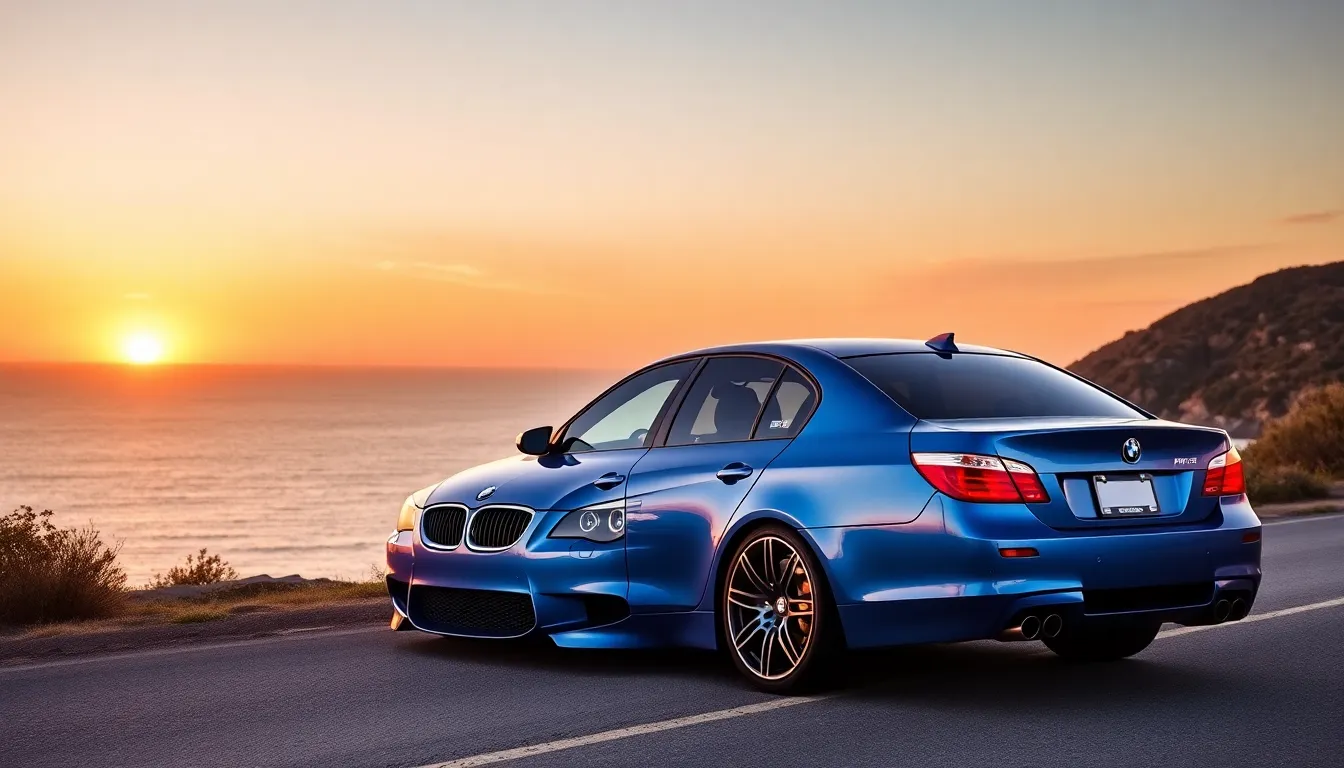
The BMW M5 E60’s market position reflects a growing recognition of its significance in automotive history even though early reliability concerns. Current market dynamics show increasing collector interest driven by the model’s unique naturally aspirated V10 engine and limited production numbers.
Current Pricing Trends
Clean examples of the M5 E60 command prices between $35,000 and $65,000 depending on mileage and condition. Low-mileage specimens with comprehensive service records trade at premium values, often exceeding $70,000 for pristine examples under 40,000 miles.
High-mileage examples typically range from $25,000 to $40,000 though buyers must factor potential engine rebuild costs of $15,000 to $25,000. Geographic markets show notable variations, with West Coast examples commanding 10-15% premiums over Midwest listings due to reduced exposure to road salt and harsh weather conditions.
Special editions like the Competition Package models or rare color combinations such as Interlagos Blue Metallic or Silverstone Metallic achieve 15-20% price premiums over standard examples. European market prices consistently exceed US values by approximately 25-30% reflecting stronger collector demand and stricter emission regulations that limit import availability.
Investment Potential
The M5 E60 demonstrates strong appreciation potential as the last naturally aspirated V10 M car in BMW’s lineup. Values increased approximately 35% between 2020 and 2024, outpacing inflation and many traditional investment vehicles.
Collector demand stems from the model’s Formula 1-derived engine technology and its position as the final high-revving naturally aspirated M5 before BMW’s transition to turbocharged powertrains. Production numbers of approximately 20,000 units worldwide create natural scarcity that supports long-term value appreciation.
Well-maintained examples with documented rod bearing services present the strongest investment cases, while high-mileage examples without major service history carry important financial risk. Market analysts predict continued appreciation of 5-8% annually for premium examples as supply decreases and collector recognition grows.
The model’s controversial reception during its production years paradoxically enhances its collectibility today, similar to other initially polarizing performance cars that later achieved iconic status. Preservation quality becomes increasingly critical as surviving examples diminish, making concours-level specimens particularly valuable for serious collectors.
Conclusion
The BMW M5 E60 stands as one of the most fascinating chapters in M division history. We’ve witnessed how this remarkable machine redefined what a high-performance sedan could be while establishing itself as a future classic even though its complexities.
For enthusiasts considering ownership we recommend approaching this vehicle with both passion and pragmatism. The reward of experiencing that legendary V10 engine comes with responsibilities that extend far beyond the initial purchase price.
Today’s market reflects growing appreciation for the E60’s unique position in automotive evolution. As values continue their upward trajectory we’re seeing increased recognition of this model’s significance among collectors and driving purists alike.
The M5 E60 eventually represents BMW’s willingness to push boundaries even when the path wasn’t straightforward. It’s a testament to engineering ambition that continues to captivate us more than two decades after its debut.
Frequently Asked Questions
What engine does the BMW M5 E60 have?
The BMW M5 E60 features a hand-built 5.0-liter naturally aspirated V10 engine (S85B50) that produces 500 horsepower and 383 lb-ft of torque. This Formula 1-influenced engine has individual throttle bodies for each cylinder, a 10.2:1 compression ratio, and VANOS variable valve timing, with a redline of 8,250 RPM.
How fast is the BMW M5 E60?
The BMW M5 E60 accelerates from 0-60 mph in just 4.1 seconds and completes the quarter-mile in 12.6 seconds. Its top speed is electronically limited to 155 mph. The car achieves exceptional track performance with lateral acceleration of 0.89g and impressive cornering capabilities.
What are common reliability issues with the M5 E60?
The most significant issue is rod bearing wear, affecting approximately 60% of high-mileage examples. Other common problems include VANOS system malfunctions and SMG III transmission issues. These reliability concerns require careful maintenance and can lead to expensive repairs if not addressed promptly.
How much does it cost to maintain a BMW M5 E60?
Annual maintenance costs average $4,500-$6,500, making the M5 E60 one of the more expensive BMWs to maintain. High parts costs, specialized service requirements, and potential engine rebuilds contribute to these elevated ownership expenses. Preventive care programs are highly recommended.
What is the current market value of a BMW M5 E60?
Clean examples currently range from $35,000 to $65,000, with low-mileage specimens exceeding $70,000. High-mileage examples cost $25,000-$40,000 but may require engine rebuilds. Values have appreciated approximately 35% between 2020 and 2024, with continued growth expected.
What makes the M5 E60’s design unique?
The M5 E60 features aggressive styling with larger air intakes, flared wheel arches, unique side gills, and quad exhaust outlets. Exclusive colors like Silverstone Metallic and Interlagos Blue Metallic complement its performance design. The car rides on 19-inch forged aluminum wheels that reduce unsprung weight.
Is the BMW M5 E60 a good investment?
Yes, the M5 E60 shows strong collectible potential due to its unique V10 engine technology and limited production numbers. Market analysts predict continued appreciation of 5-8% annually for premium examples. However, factor in high maintenance costs when considering investment potential.

